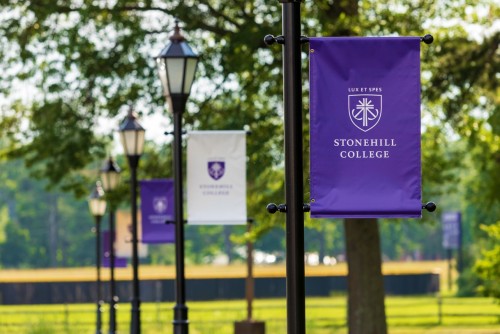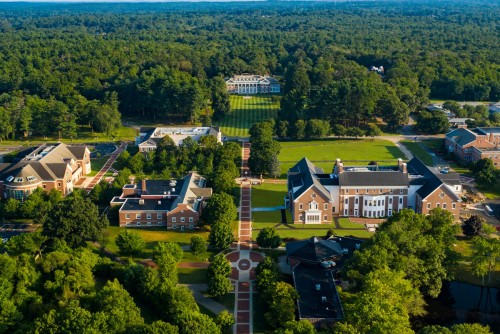Compassion, Career Align in Quest To Help 9/11 Families
The knowledge and value system instilled at Stonehill inspire an alum as he leverages DNA science to help victims' families find closure 20 years later.
On Sept. 11, 2001, Andrew Schweighardt ’06 stood shoulder to shoulder with classmates in his high school’s senior lounge, watching incredulously as the World Trade Center’s South Tower collapsed. Like many others, Andrew witnessed the event with a family member’s heartbreak: His 27-year-old cousin, Joseph, worked on the 104th floor of the tower. Though Andrew already envisioned a career in forensics — “science can triumph over evil,” he wrote in his yearbook — he was unaware then how that day’s events would lead him, years later, to the front lines of one of the most historically significant forensic investigations ever undertaken.
Service and Science Intersect
“Do something good for someone every day” was a motto Andrew had learned from a youth encompassing time spent in the Boy Scouts and a job at the YMCA. That same drive drew him to Stonehill, where he sensed that his core values would align with the College’s.
“Like many students, Andrew came to Stonehill interested in training for a particular career, but our aim is to educate, rather than to train, students,” says Louis Liotta, professor of chemistry and program director, biochemistry. “Our faculty embody the values of hard work, compassion, integrity and justice that we try to instill in all students.”
While Andrew’s biochemistry major conveyed the science behind forensic techniques, courses in philosophy, religious studies, literature and history shed light on human complexity. Like all Stonehill science majors, Andrew gained applied experience, with support from faculty members and through supervised summer internships at the Suffolk County Crime Lab in Long Island, New York. The unique intersection of perspectives propelled him through a Ph.D. program in forensic science at The City University of New York and then to his role as a criminalist with the New York City Office of the Chief Medical Examiner (OCME). There, he is part of ongoing efforts to match DNA — the majority from human bone fragments — with the approximately 1,100 9/11 victims whose remains were never identified.
“At Stonehill, it wasn’t just about education — it was about learning what’s right and wrong, and having compassion in the work itself,” Andrew says. “The fortunate thing about my World Trade Center work is that we’re not just scientists in white lab coats with no emotions; many of us lost loved ones on 9/11 ourselves. We have the opportunity to sympathize with families — and at Stonehill, I sharpened my ability to communicate about science with compassion.”
‘A Sacred Job’
Though other crime labs may have ceased their efforts after initial unsuccessful attempts to extract DNA from bone — a scientifically challenging undertaking using earlier technology — Andrew notes that the OCME’s shared commitment to 9/11 families has compelled the team to test some samples up to a dozen times over the years, as innovation yields better results. Many advances, including mechanical demineralization procedures exposing DNA from protective bone, are protocols born out of the unique work of 9/11 recovery itself. “This is such a sacred job — we have the deepest respect for the families involved and want to earn their trust,” explains Andrew. “We want them to know we’re working hard to make long-awaited identifications for the 40% of victims whose remains required science to catch up.”
Mary Fetchet, mother of 9/11 victim Brad Fetchet, says the continued efforts of the OCME have brought “great solace” to families. “In his work at the OCME, Andrew Schweighardt exemplifies the highest of standards in his commitment to the 9/11 families, serving in his capacity with integrity, compassion and dedication to his tireless work,” says Fetchet, who is the executive director of the Voices Center for Resilience (VOICES).
Andrew says that the rare connection and acknowledgement from those directly impacted by justice, rendered through his dedication, is the ultimate reward. “This is a unique opportunity in which everything comes full circle and we can see firsthand the true meaning of our work,” he adds.
Related
-
Request Information
Sign up now to be added to our mailing list, and we will show you how Stonehill could become part of your story.
-
Visit Opportunities
Our visit programs will help give you a better understanding of how Stonehill’s expansive leadership and experiential learning opportunities equip students for success in a rapidly evolving and globally competitive world.
-
Apply for Admission
Stonehill College provides an exceptional learning experience for both undergraduate and graduate students. We invite you to review the process, requirements and application deadlines for our entry options.
The Office of Communications and Media Relations is the official source of news and information at Stonehill. It is the main point of contact between the College and the news media and plays a key role during emergency situations.


